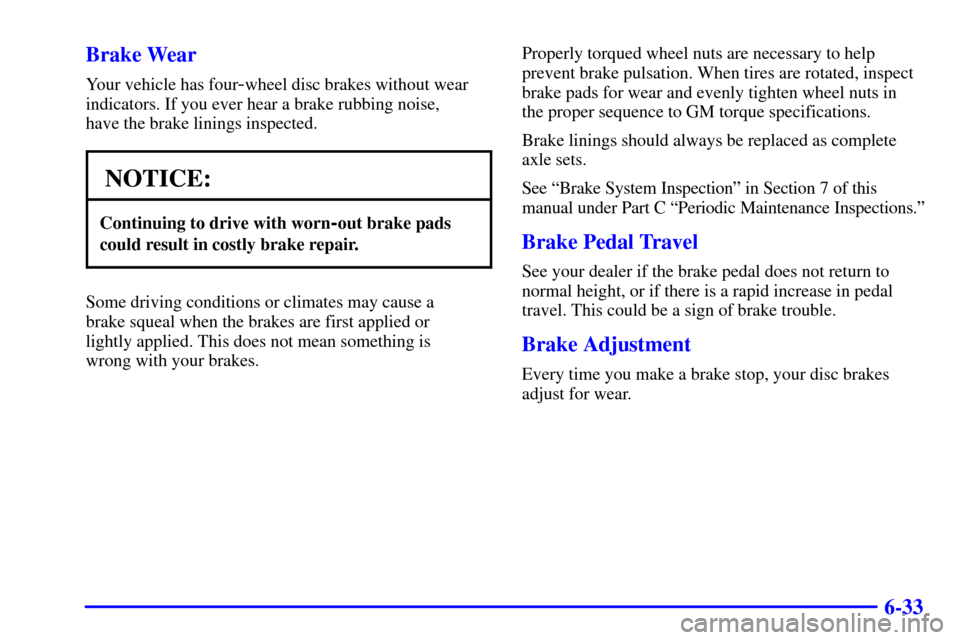Page 176 of 331

5-4
If your vehicle has more than one battery, use the
battery that's closer to the starter
-- this will reduce
electrical resistance.
2. Get the vehicles close enough so the jumper cables
can reach, but be sure the vehicles aren't touching
each other. If they are, it could cause a ground
connection you don't want. You wouldn't be able to
start your vehicle, and the bad grounding could
damage the electrical systems.
3. To avoid the possibility of the vehicles rolling, set
the parking brake firmly on both vehicles involved in
the jump start procedure. Put an automatic
transmission in PARK (P) or a manual transmission
in NEUTRAL before setting the parking brake.
NOTICE:
If you leave your radio on, it could be badly
damaged. The repairs wouldn't be covered by
your warranty.
4. Turn off the ignition on both vehicles. Unplug
unnecessary accessories plugged into the cigarette
lighter or accessory power outlets. Turn off the radio
and all lamps that aren't needed. This will avoid
sparks and help save both batteries. And it could
save your radio!
5. Open the hoods and locate the batteries. Find the
positive (+) and negative (
-) terminal locations
on each vehicle. On vehicles equipped with dual
batteries, make any battery connections to the
primary battery located on the passenger's side of the
vehicle. See ªEngine Compartment Overviewº in the
Index for more information on location.
CAUTION:
If your vehicle has air conditioning, the auxiliary
electric fan under the hood can start up even
when the engine is not running and can injure
you. Keep hands, clothing and tools away from
any underhood electric fan.
Page 228 of 331

6-33 Brake Wear
Your vehicle has four-wheel disc brakes without wear
indicators. If you ever hear a brake rubbing noise,
have the brake linings inspected.
NOTICE:
Continuing to drive with worn-out brake pads
could result in costly brake repair.
Some driving conditions or climates may cause a
brake squeal when the brakes are first applied or
lightly applied. This does not mean something is
wrong with your brakes.Properly torqued wheel nuts are necessary to help
prevent brake pulsation. When tires are rotated, inspect
brake pads for wear and evenly tighten wheel nuts in
the proper sequence to GM torque specifications.
Brake linings should always be replaced as complete
axle sets.
See ªBrake System Inspectionº in Section 7 of this
manual under Part C ªPeriodic Maintenance Inspections.º
Brake Pedal Travel
See your dealer if the brake pedal does not return to
normal height, or if there is a rapid increase in pedal
travel. This could be a sign of brake trouble.
Brake Adjustment
Every time you make a brake stop, your disc brakes
adjust for wear.
Page 260 of 331
6-65
Name Usage
Horn Relay Horn
ECM
-B Fuel Pump, PCM/VCM
RR DEFOG Not Used
IGN
-E A/C Compressor Relay,
Dual Tanks
Blank Not Used
Blank Not Used
Blank Not Used
HORN Horn, Underhood Lamps
AUX FAN Not Used
ECM
-1 Injectors, PCM/VCM, Fuel
Solenoid (Diesel Engine) Fuel
Control Module (Diesel Engine)
HTD ST
-FR Not Used
Blank Not Used
Blank Not Used
A/C Air Conditioning
PTO PTO RelayName Usage
ENG
-1 Ignition Switch, Exhaust Gas
Recirculation, Canister Purge,
EVRV Idle Coast Solenoid, MAF,
Heated O
2, Fuel Heater (Diesel
Engine), Water Sensor (Diesel
Engine), Boost Solenoid (Diesel
Engine), EPR (Diesel Engine)
HTD ST
-RR Not Used
Blank Not Used
Diode Not Used
LIGHTING Headlamp and Panel Dimmer
Switch, Fog and Courtesy Fuses
BATT Battery, Fuse Block Busbar
IGN A Ignition Switch
IGN B Ignition Switch
ABS Anti
-Lock Brake Module
BLOWER High Blower Relay
STOP/HAZ Stoplamps
HEATED
SEATSNot Used